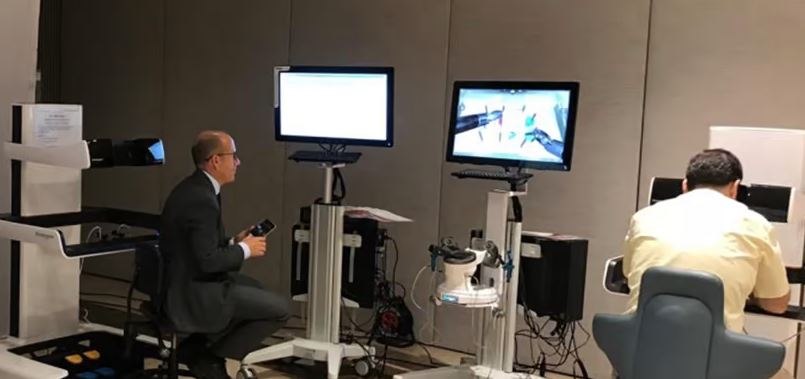Customer Company Size
Large Corporate
Region
- Europe
Country
- United Kingdom
Product
- ICONICS’ GENESIS64™
- ICONICS BizViz™
Tech Stack
- OPC technology
- SNMP
- Web Services
- BACnet
- OLEDB
Implementation Scale
- Enterprise-wide Deployment
Impact Metrics
- Environmental Impact Reduction
- Productivity Improvements
Technology Category
- Application Infrastructure & Middleware - API Integration & Management
- Application Infrastructure & Middleware - Data Exchange & Integration
Applicable Industries
- Education
Applicable Functions
- Facility Management
Use Cases
- Building Automation & Control
- Building Energy Management
- Energy Management System
Services
- Software Design & Engineering Services
- System Integration
About The Customer
The University of Bristol (UoB) is one of the top-ranking universities in the UK. It has 25 academic schools arranged across six different facilities. The University owns over 600 hectares of land in and around Bristol and makes use of over 370 buildings. The buildings range in age from the late 17th century to the 21st century. With such a large number of buildings, estate management is very important. The University was looking for a modern, future-proof solution platform that would allow them to continue to build new capabilities as new equipment and buildings were needed and connected to the Secure Data network (SDN). The University needed a company with reliable software solutions that could meet several objectives, including providing all departments of the University with accommodations of quality and functionality, ensuring the most efficient use of all built space, working to reduce the University’s carbon emissions, and enabling Building Management System (BMS), Fire Monitoring, Critical Alarms, Sustainability Monitoring, etc.
The Challenge
The University of Bristol (UoB) is a top-ranking university in the UK with a vast estate comprising over 600 hectares of land and more than 370 buildings. The buildings range in age from the late 17th century to the 21st century. Given the large number of buildings, estate management is crucial. A major requirement of the project was to integrate the buildings together to provide a secure, future-proof centralized building management solution. The UoB was looking for a modern, future-proof solution platform that would allow them to continue to build new capabilities as new equipment and buildings were needed and connected to the Secure Data network (SDN). The University needed a company with reliable software solutions that could meet several objectives, including providing all departments of the University with accommodations of quality and functionality, ensuring the most efficient use of all built space, working to reduce the University’s carbon emissions, and enabling Building Management System (BMS), Fire Monitoring, Critical Alarms, Sustainability Monitoring, etc.
The Solution
The University of Bristol selected Cougar Automation Ltd., a Microsoft Certified Partner and winner of numerous customer experience awards, who in conjunction with ICONICS, provided a GENESIS64 based visualization solution. Together with a calendar scheduler to integrate and manage the Trend IQ2 and IQ3 BACnet controllers across the facilities, they received a single consistent head-end visualisation for all BMS functions allowing the University to reduce training and maintenance costs, another key driver of the SDN project. The comprehensive alarms management capabilities in GENESIS64 also allowed critical BMS alarms to be routed to the Estates Security Office during non-working hours, by raising and lowering their priorities automatically, ensuring that critical facilities are continuously monitored 24 hours a day. In addition to the standard SCADA capability that GENESIS64 was able to provide, the Cougar project team also utilised ICONICS BizViz™ integration capabilities with great success.
Operational Impact

Case Study missing?
Start adding your own!
Register with your work email and create a new case study profile for your business.
Related Case Studies.

Case Study
Revolutionizing Medical Training in India: GSL Smart Lab and the LAP Mentor
The GSL SMART Lab, a collective effort of the GSL College of Medicine and the GSL College of Nursing and Health Science, was facing a challenge in providing superior training to healthcare professionals. As clinical medicine was becoming more focused on patient safety and quality of care, the need for medical simulation to bridge the educational gap between the classroom and the clinical environment was becoming increasingly apparent. Dr. Sandeep Ganni, the director of the GSL SMART Lab, envisioned a world-class surgical and medical training center where physicians and healthcare professionals could learn skills through simulation training. He was looking for different simulators for different specialties to provide both basic and advanced simulation training. For laparoscopic surgery, he was interested in a high fidelity simulator that could provide basic surgical and suturing skills training for international accreditation as well as specific hands-on training in complex laparoscopic procedures for practicing physicians in India.

Case Study
IoT platform Enables Safety Solutions for U.S. School Districts
Designed to alert drivers when schoolchildren are present, especially in low-visibility conditions, school-zone flasher signals are typically updated manually at each school. The switching is based on the school calendar and manually changed when an unexpected early dismissal occurs, as in the case of a weather-event altering the normal schedule. The process to reprogram the flashers requires a significant effort by school district personnel to implement due to the large number of warning flashers installed across an entire school district.

Case Study
Implementing Robotic Surgery Training Simulator for Enhanced Surgical Proficiency
Fundacio Puigvert, a leading European medical center specializing in Urology, Nephrology, and Andrology, faced a significant challenge in training its surgical residents. The institution recognized the need for a more standardized and comprehensive training curriculum, particularly in the area of robotic surgery. The challenge was underscored by two independent studies showing that less than 5% of residents in Italian and German residency programs could perform major or complex procedures by the end of their residency. The institution sought to establish a virtual reality simulation lab that would include endourological, laparoscopic, and robotic platforms. However, they needed a simulator that could replicate both the hardware and software of the robotic Da Vinci console used in the operating room, without being connected to the actual physical console. They also required a system that could provide both basic and advanced simulation training, and a metrics system to assess the proficiency of the trainees before they performed surgical procedures in the operating theater.

Case Study
Edinburgh Napier University streamlines long-distance learning with Cisco WebEX
• Geographically dispersed campus made in-person meetings costly and inconvenient.• Distance-learning programs in Malaysia, India, and China required dependable, user-friendly online tools to maximize interaction in collaborative workspaces.• Virtual learning environment required a separate sign-in process, resulting in a significant administrative burden for IT staff and limited adoption of collaboration technology.

Case Study
8x increased productivity with VKS
Before VKS, a teacher would spend a lot of time showing a group of 22 students how to build a set of stairs within a semester of 120 hours. Along with not leaving the teacher much time to provide one-on-one support for each student to properly learn carpentry, it also left a considerable amount of room for error. Key information would be misinterpreted or lost as the class was taught in the typical show-and-tell way.

Case Study
Scalable IoT Empowering GreenFlex's Sustainable Growth
GreenFlex, a company that supports sustainable development, decarbonization, and energy efficiency, faced several challenges in its quest to expand its business. The company needed to deploy a robust and sustainable IoT technology to support its growth. It was crucial for them to monitor and control devices at customer sites in a safe and reliable manner. They also needed to integrate devices across a range of communication protocols and gather and act on data to meet efficiency targets. GreenFlex had previously built IoT capabilities into its digital platform, GreenFlexIQ, to monitor and manage customer sites remotely. However, they soon realized that they needed a new platform to support their ambitions. They needed a platform that could scale to connect more devices for production management and make it easier for the operations team to manage devices in the field.






